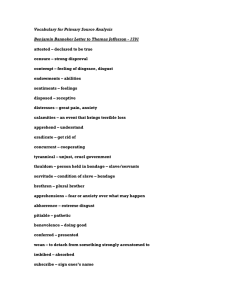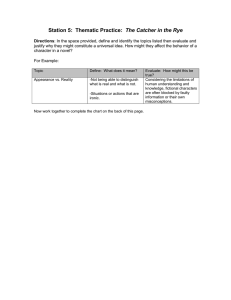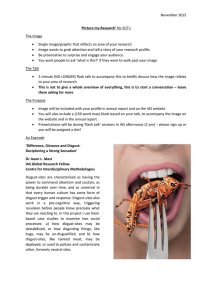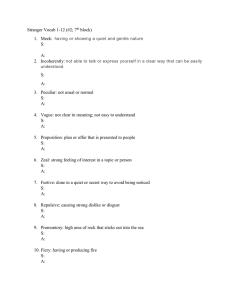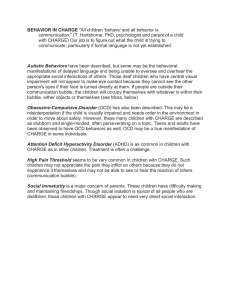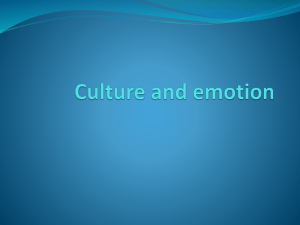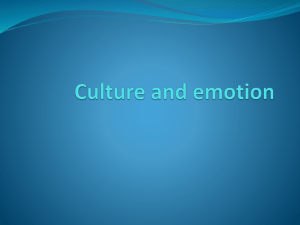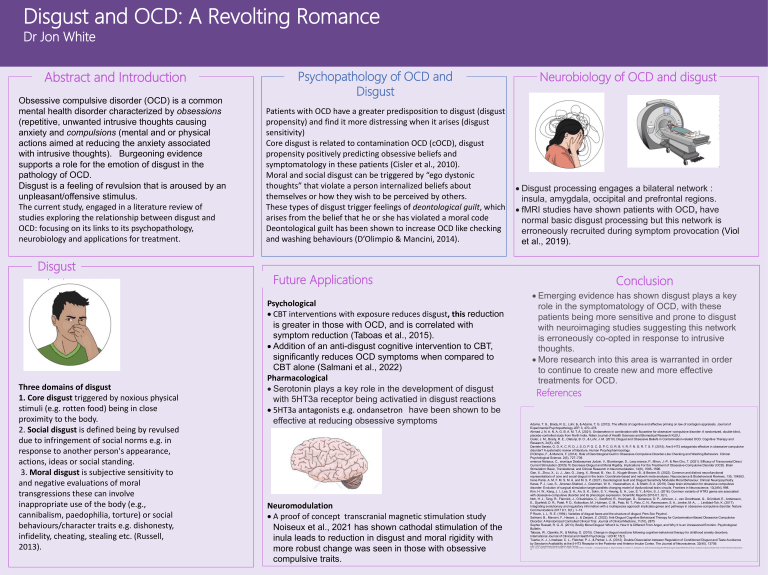
Disgust and OCD: A Revolting Romance Dr Jon White Abstract and Introduction Obsessive compulsive disorder (OCD) is a common mental health disorder characterized by obsessions (repetitive, unwanted intrusive thoughts causing anxiety and compulsions (mental and or physical actions aimed at reducing the anxiety associated with intrusive thoughts). Burgeoning evidence supports a role for the emotion of disgust in the pathology of OCD. Disgust is a feeling of revulsion that is aroused by an unpleasant/offensive stimulus. The current study, engaged in a literature review of studies exploring the relationship between disgust and OCD: focusing on its links to its psychopathology, neurobiology and applications for treatment. Disgust Three domains of disgust 1. Core disgust triggered by noxious physical stimuli (e.g. rotten food) being in close proximity to the body. 2. Social disgust is defined being by revulsed due to infringement of social norms e.g. in response to another person's appearance, actions, ideas or social standing. 3. Moral disgust is subjective sensitivity to and negative evaluations of moral transgressions these can involve inappropriate use of the body (e.g., cannibalism, paedophilia, torture) or social behaviours/character traits e.g. dishonesty, infidelity, cheating, stealing etc. (Russell, 2013). Psychopathology of OCD and Disgust Patients with OCD have a greater predisposition to disgust (disgust propensity) and find it more distressing when it arises (disgust sensitivity) Core disgust is related to contamination OCD (cOCD), disgust propensity positively predicting obsessive beliefs and symptomatology in these patients (Cisler et al., 2010). Moral and social disgust can be triggered by “ego dystonic thoughts” that violate a person internalized beliefs about themselves or how they wish to be perceived by others. These types of disgust trigger feelings of deontological guilt, which arises from the belief that he or she has violated a moral code Deontological guilt has been shown to increase OCD like checking and washing behaviours (D’Olimpio & Mancini, 2014). Neurobiology of OCD and disgust Disgust processing engages a bilateral network : insula, amygdala, occipital and prefrontal regions. fMRI studies have shown patients with OCD, have normal basic disgust processing but this network is erroneously recruited during symptom provocation (Viol et al., 2019). Future Applications Psychological CBT interventions with exposure reduces disgust, this reduction is greater in those with OCD, and is correlated with symptom reduction (Taboas et al., 2015). Addition of an anti-disgust cognitive intervention to CBT, significantly reduces OCD symptoms when compared to CBT alone (Salmani et al., 2022) Pharmacological Serotonin plays a key role in the development of disgust with 5HT3a receptor being activatied in disgust reactions 5HT3a antagonists e.g. ondansetron have been shown to be effective at reducing obsessive symptoms Neuromodulation A proof of concept transcranial magnetic stimulation study Noiseux et al., 2021 has shown cathodal stimulation of the inula leads to reduction in disgust and moral rigidity with more robust change was seen in those with obsessive compulsive traits. Conclusion Emerging evidence has shown disgust plays a key role in the symptomatology of OCD, with these patients being more sensitive and prone to disgust with neuroimaging studies suggesting this network is erroneously co-opted in response to intrusive thoughts. More research into this area is warranted in order to continue to create new and more effective treatments for OCD. References Adams, T. G., Brady, R. E., Lohr, &, & Adams, T. G. (2012). The effects of cognitive and affective priming on law of contagion appraisals. Journal of Experimental Psychopathology JEP, 3, 470–478. Ahmad J, N. A. N. A. G. B. A. M. T. A. (2021). Ondansetron in combination with fluoxetine for obsessive–compulsive disorder: A randomized, double-blind, placebo-controlled study from North India. Ndian Journal of Health Sciences and Biomedical Research KLEU. Cisler, J. M., Brady, R. E., Olatunji, B. O., & Lohr, J. M. (2010). Disgust and Obsessive Beliefs in Contamination-related OCD. Cognitive Therapy and Research, 34(5), 439. Daniele Serata, G. D. K. C. R. D. J. S. D. P. G. C. D. P. C. G. R. B. V. R. F. N. G. R. T. S. F. (2015). Are 5-HT3 antagonists effective in obsessive-compulsive disorder? A systematic review of literature. Human Pscyhopharmacology. D’Olimpio, F., & Mancini, F. (2014). Role of Deontological Guilt in Obsessive-Compulsive Disorder-Like Checking and Washing Behaviors. Clinical Psychological Science, 2(6), 727–739. emence Noiseux, C., eronique Desbeaumes Jodoin, V., Blumberger, D., Lesp erance, P., Miron, J.-P., & Ren Chu, T. (2021). Efficacy of Transcranial Direct Current Stimulation (tDCS) To Decrease Disgust and Moral Rigidity. Implications For the Treatment of Obsessive-Compulsive Disorder (OCD). Brain Stimulation: Basic, Translational, and Clinical Research in Neuromodulation, 14(6), 1595–1596. Gan, X., Zhou, X., Li, J., Jiao, G., Jiang, X., Biswal, B., Yao, S., Klugah-Brown, B., & Becker, B. (2022). Common and distinct neurofunctional representations of core and social disgust in the brain: Coordinate-based and network meta-analyses. Neuroscience & Biobehavioral Reviews, 135, 104553. Irene Parisi, A. M. F. M. S. M. A. and M. S. P. (2021). Deontological Guilt and Disgust Sensitivity Modulate Moral Behaviour. Clinical Neuropsychiatry. Karas, P. J., Lee, S., Jimenez-Shahed, J., Goodman, W. K., Viswanathan, A., & Sheth, S. A. (2019). Deep brain stimulation for obsessive compulsive disorder: Evolution of surgical stimulation target parallels changing model of dysfunctional brain circuits. Frontiers in Neuroscience, 13(JAN), 998. Kim, H. W., Kang, J. I., Lee, S. H., An, S. K., Sohn, S. Y., Hwang, E. H., Lee, S. Y., & Kim, S. J. (2016). Common variants of HTR3 genes are associated with obsessive-compulsive disorder and its phenotypic expression. Scientific Reports 2016 6:1, 6(1), Noh, H. J., Tang, R., Flannick, J., O’dushlaine, C., Swofford, R., Howrigan, D., Genereux, D. P., Johnson, J., van Grootheest, G., Grünblatt, E., Andersson, E., Djurfeldt, D. R., Patel, P. D., Koltookian, M., Hultman, C. M., Pato, M. T., Pato, C. N., Rasmussen, S. A., Jenike, M. A., … Lindblad-Toh, K. (2017). Integrating evolutionary and regulatory information with a multispecies approach implicates genes and pathways in obsessive-compulsive disorder. Nature Communications 2017 8:1, 8(1), 1–13. P Rozin, L. L. R. E. (1994). Varieties of disgust faces and the structure of disgust. Pers Soc Psychol . Salmani, B., Mancini, F., Hasani, J., & Zanjani, Z. (2022). Anti-Disgust Cognitive Behavioral Therapy for Contamination-Based Obsessive Compulsive Disorder: A Randomized Controlled Clinical Trial. Journal of Clinical Medicine, 11(10), 2875 Sophie Russell, R. G.-S. (2013). Bodily Moral Disgust: What It Is, How It Is Different From Anger, and Why It Is an Unreasoned Emotion. Psychological Bulletin . Taboas, W., Ojserkis, R., & McKay, D. (2015). Change in disgust reactions following cognitive-behavioral therapy for childhood anxiety disorders. International Journal of Clinical and Health Psychology : IJCHP, 15(1) Tuerke, K. J., Limebeer, C. L., Fletcher, P. J., & Parker, L. A. (2012). Double Dissociation between Regulation of Conditioned Disgust and Taste Avoidance by Serotonin Availability at the 5-HT3 Receptor in the Posterior and Anterior Insular Cortex. The Journal of Neuroscience, 32(40), 13709. Veale, D. (2007). Psychopathology of obsessive–compulsive disorder. Psychiatry. Viol, K., Aas, B., Kastinger, A., Kronbichler, M., Schöller, H. J., Reiter, E. M., Said-Yürekli, S., Kronbichler, L., Kravanja-Spannberger, B., Stöger-Schmidinger, B., Aichhorn, W., & Schiepek, G. K. (2019). Erroneously Disgusted: fMRI Study Supports Disgust-Related Neural Reuse in Obsessive-Compulsive Disorder (OCD). Frontiers in Behavioral Neuroscience, 13.
